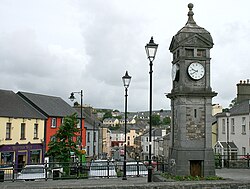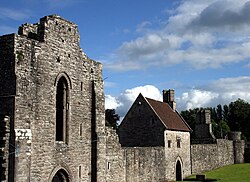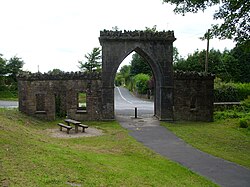Boyle, County Roscommon
| Boyle Irish: Mainistir na Búille | |
| County Roscommon | |
|---|---|
 Market Square, Boyle | |
| Location | |
| Grid reference: | G797019 |
| Location: | 53°58’23"N, 8°18’4"W |
| Data | |
| Population: | 2,588 (2011) |
| Post town: | Boyle |
| Postcode: | F52 |
| Local Government | |
| Council: | Boyle MD |
Boyle is a town in County Roscommon. It is located at the foot of the Curlew Mountains near Lough Key in the north of the county. Carrowkeel Megalithic Cemetery, the Drumanone Dolmen and the lakes of Lough Arrow and Lough Gara are also close by.
Contents
History
Early history
On 15 August 1599, the Battle of Curlew Pass between English and Irish forces was fought in the Curlew mountains during the Nine Years' War, between an English force under Sir Conyers Clifford and a native Irish force led by Aodh Ruadh Ó Domhnaill (Red Hugh O'Donnell). The English were ambushed and routed while marching through a pass in the Curlew Mountains, with the English forces suffering heavy casualties. Losses by allied Irish forces were not recorded.
19th century
In 1859, Fraser's Ireland described Boyle as including a sessions-house, hospitals, schools, the houses and offices for the agents of the Lorton Estate, the police barracks, Church, Methodist chapel, public garden. The entry also noted the preservation of the fine ruins of the Abbey of Boyle, one of the most interesting of all our ecclesiastical structures, and that the town was one of the principal towns of County Roscommon, and carries on a considerable retail trade in the supply of necessaries for the surrounding district.[1]
By 1881 Slater's directory reported the town had a dispensary, three banks, three hotels and two newspapers. Boyle also had a post office, 40 grocery shops, 25 pubs (sixteen of which were also groceries), 12 bakeries and an assortment of businesses including fire insurance companies, booksellers, ironmongers and hardware stores, butchers, an auctioneer and churches for both Protestants and Catholics.
20th century
In 1917, Sinn Féin won their first ever seat in parliament for the constituency of North Roscommon, with the election of George Noble Plunkett. Plunkett's son, Joseph Mary Plunkett, had been executed in May 1916 for his association with the 1916 Rising.
Landmarks
King House
King House is an early Georgian mansion located in the centre of the town and was restored in 1989 after some years of neglect, including surviving potential demolition for a car park.[2] The house was built for Sir Henry King (d. 1839) MP, 3rd. Lord Kingston, between 1720 and 1740, whose family were one of the most wealthy in Ireland. It was subsequently home to Edward King MP (1726–97), first earl of Kingston. The design is attributed to William Halfpenny (d. 1755) who was an assistant to Edward Lovett Pearce.[3]
The large 'U' shaped house may incorporate walls from an earlier 17th century house which was burnt.[4] It is unusual in Ireland for the 'big house' to be located in the town, as most houses are situated in a demesne. It is also unusual for the floors to be vaulted. Perhaps, according to Rev. Daniel Beaufort, this is a response to the earlier fire.Template:Fact
Since 1810, when the King Family moved to Rockingham, the house had been used as a military barracks. Throughout the nineteenth century it was the home of the Connaught Rangers, adapted as a barracks for twelve officers and 260 soldiers. On the foundation of the Irish Free State in 1922, the newly formed Irish National Army took possession of the house and it was renamed Dockery Barracks in honour of a commanding officer killed in Boyle during the Civil War.
Roscommon County Council purchased the building in 1987 and began a restoration project in 1989 following years of neglect. Using artisans and local craftsmen who employed traditional techniques and materials, the three floors and basement were restored. Included in the restoration were the main entrance gallery with its tripate windows and original fireplace, the vaulted ceilings on all floors, and the main salon which is in use again as a venue for recitals and banquets. The other rooms in the house are used for temporary exhibitions and these are open to visitors. In The Kings of Connaught exhibition, visitors are led through a series of tableaux. The displays, ranging all over the floors, cover four main themes: The Kingdom of Connaught - from the earliest recorded times showing the importance of the clans and their kings; The King Family - meet the families who lived in the house from Sir John King who came to Boyle in 1603 to the fascinating accounts of life, both for the family and the staff, at Rockingham Estate (now Lough Key Forest Park); The Restoration - a room left partially restored so that visitors can see the fabric of the house.
Boyle Abbey
The Cistercian abbey was founded in the 12th century under the patronage of the local ruling family, the MacDermotts and is one of the best preserved in Ireland.Template:Fact It was colonised from Mellifont in 1161. The building of the chancel and the transepts with their side-chapels probably began shortly after this date, though the lancet windows in the east gable were inserted in the 13th century. There is a combination of rounded and pointed arches in the transepts and crossing. The existing large square tower formed part of the church from the beginning, though it was raised in height at a later stage. The five eastern arches of the nave and their supporting pillars were built at the end of the 12th century, and have well-preserved capitals typical of the period.Template:Fact Although built at the same time, the arches of the northern side of the nave are different in type, and have differently shaped columns and capitals. The three westernmost arches in the south arcade which have leafed and figured capitals, were built after 1205, as was the west wall, before the church was finally consecrated in 1218. Nothing remains of the cloister, but on the eastern side there are two doorways of c.1200, now blocked up. On the west side there is a two-storey gatehouse, which acts as an interpretative centre. The rest of the buildings surrounding the cloister are largely 16th or 17th century. The Abbey was one of the most important in Connaught, and was invaded by Richard de Burgo, Maurice Fitzgerald, and Justiciar, in 1235. In 1659, the Cromwellians occupied the monastery and did a great deal of destruction. Though damaged during the 17th and 18th centuries when it was used to accommodate a military garrison, Boyle Abbey is one of the best preserved structures of its type, and attracts thousands of visitors per year. A restored gatehouse of 16th/17th century vintage houses an exhibition. The Abbey is now a national monument in state care and admission is currently free while restoration work is being carried out.
There is a Sheela na gig hidden above one of the central Romanesque arches. It can be seen from ground level, just at the top of the column, where the arch begins.
Lough Key Forest Park
Situated off the N4 road is Lough Key Forest Park, a parkland area that has a visitor centre and activity facilities, including Boda Borg, a puzzle-solving activity centre which is a Swedish concept originally unique to Sweden.[5] The park covers 800 acres, and was formerly part of the Rockingham estate. This was the seat of the Stafford-King-Harman[6] family who at the end of the nineteenth century held over 30,000 acres in northern County Roscommon and County Sligo. Rockingham House was designed by John Nash in the early 19th century for the landlord John King. It had a domed front and 365 windows.
Rockingham House was suspiciously destroyed by fire in 1957, after which it was taken over by the Irish Land Commission. Declared as unsafe in 1970, it was demolished. A viewing tower was built in 1973. In the town park, known locally as the Pleasure Grounds behind King House stood a statue of William of Orange. This was pulled down and destroyed by locals in 1945, though the base of the statue remains.[7]
There are several islands on Lough Key. Castle Island is among the better known islands, while Trinity Island contains the ruins of a chapel, linked to the Cistercian monastery in the town. There are two trees growing on the island with interlinked branches, said to mark the graves of Una Bhan Mac Diarmid and Tomás Láidir Mac Coisdealbhaigh, two ill-fated lovers, celebrated in the poem Una Bhan.
Other places of interest
Abbeytown bridge is a five-arch stone bridge across the Boyle river close to the abbey. Originally built in the late 12th Century, it is one of the oldest surviving stone bridges in Ireland.[8] It has been widened but still carries a 5-ton load.
The Drumanone Dolmen (portal tomb) just west of the town is a site of archaeological significance. This Dolmen located outside Boyle, is an example of a portal dolmen, and was built before 2000BC. The capstone of the tomb, 15ft x 10ft wide, is one of the largest to be seen in Ireland. Drumanone Dolmen has portal stones more than 6ft 6in high and a doorstone about the same hight. The capstone is about 40ft square and has slipped back to cover the polygonal chamber. The sides of the chamber are each composed of a single stone. It is located in pasture land approximately 300 yds north of the Boyle River.
Transport
Boyle railway station opened on 3 December 1862.[9] Boyle lies on the railway line from Dublin to Sligo, and the N4 Dublin-Sligo main road skirts the town. The town is linked to the River Shannon navigation system via the Boyle canal, the River Boyle and Lough Key. The town was once on the N4 national primary road from Dublin to Sligo but was bypassed in 1999. It is connected to the N4 by the R294 regional road (which also connects it to Ballina, County Mayo) and the N61 national secondary road which links Boyle to Athlone via Roscommon.
Boyle has a bus service to Roscommon three times daily.
People
Boyle is the birthplace of actress Maureen O'Sullivan (Jane in the Tarzan movies), writer Patrick Chapman, Suffragette and women's rights campaigner Margaret Cousins, physician Robert Cryan, and is the home town of actor and comedian Chris O'Dowd. O'Dowd filmed segments of his comedy Moone Boy in the town during 2012 and 2013. Neville Knott, interior designer and television personality also lives locally,[10] and orchestral conductor Michael Bowles (1909–1998) grew up in Boyle.
The writer John McGahern grew up near Boyle and Boyle is mentioned in several of his books. In his novel The Dark, a scene is played out in the dining room of the Royal Hotel, overlooking the river.
Singer John Reilly lived in Boyle. He is credited by Christy Moore as a source of several well-known folk standards, such as 'The Well Below The Valley' (attributed to Reilly), and 'The Raggle Taggle Gypsy' (not a local song). Cited as an influence by Sinead O Connor and John Hoban, Reilly features on three albums on the Topic Records label. The John Reilly Music Room was a local music venue for some years. Other local recording artists include the Grehan Sisters, who released two albums on the Transatlantic Records label and featured on a number of Irish music compilations. Christy Moore's first broadcast was as a guest performer on the Grehan Sisters BBC radio series. London-born John Carty is an Irish traditional musician and has lived in Boyle since 2003.
Former President of Ireland, Mary McAleese, has a holiday home near Boyle, as does Emmy-winning actor Brendan Gleeson.
Arts festival
Boyle Arts Festival is a summer event and has been held since 1990 - with the 2016 event billed as the 27th festival.[11] Events include an art exhibition of works by contemporary Irish artists, classical and traditional music, poetry, drama, lectures and children's events.[12]
Shops and services
Boyle has a number of shops and services, with supermarket outlets like SuperValu, Centra and Mace operating stores within the town. Boyle also serves as a commercial centre for surrounding villages, such as Ballinameen and Corrigeenroe. The town is also home to smaller businesses, including butchers, newsagents, grocery stores, florists and clothes shops.[13]
References
- ↑ Handbook for travellers in Ireland, descriptive of its scenery, towns, seats, antiquities etc. by James Fraser. (Dublin, 1859),
- ↑ "Building of the Month - February 2013 King House". February 2013. http://www.buildingsofireland.ie/Surveys/Buildings/BuildingoftheMonth/Archive/Name,2254,en.html. Retrieved 29 December 2016.
- ↑ "King House, Boyle, Co. Roscommon". September 2013. http://www.historyireland.com/early-modern-history-1500-1700/king-house-boyle-co-roscommon/. Retrieved 17 August 2015.
- ↑ Mark Bence-Jones, Burke's Guide to Country Houses
- ↑ http://www.bodaborg.com/Boda-Borg-Locations.html
- ↑ Edward Robert King-Harman
- ↑ http://www.ggy.bris.ac.uk/personal/YvonneWhelan/HistoricalGeographyArtice.pdf
- ↑ "Creative crossings". Irish Times. 6 December 2003. http://www.irishtimes.com/news/creative-crossings-1.398055. "" There are several unproven claims to the country's oldest surviving stone bridge, notably Abbeytown bridge near Boyle, Co Roscommon, possibly built around 1200, and still in use""
- ↑ "Boyle station". Railscot - Irish Railways. http://www.railscot.co.uk/Ireland/Irish_railways.pdf. Retrieved 7 September 2007.
- ↑ "Peep beyond Neville's hall door". Irish Independent. 13 January 2002. http://www.independent.ie/lifestyle/peep-beyond-nevilles-hall-door-498414.html. Retrieved 6 January 2013.
- ↑ "Varied programme of events announced for Boyle Arts Festival". 19 June 2016. http://roscommondaily.com/2016/06/boyle-arts-festival-launched/. Retrieved 29 December 2016. ""programme for the 27th annual Boyle Arts Festival was launched""
- ↑ Boyle Arts Festival
- ↑ "Archived copy". Archived from the original on 22 April 2012. https://web.archive.org/web/20120422051857/http://boyletm.com/tm/business-lisiting/. Retrieved 2012-02-15.
Outside links
| ("Wikimedia Commons" has material about Boyle, County Roscommon) |




